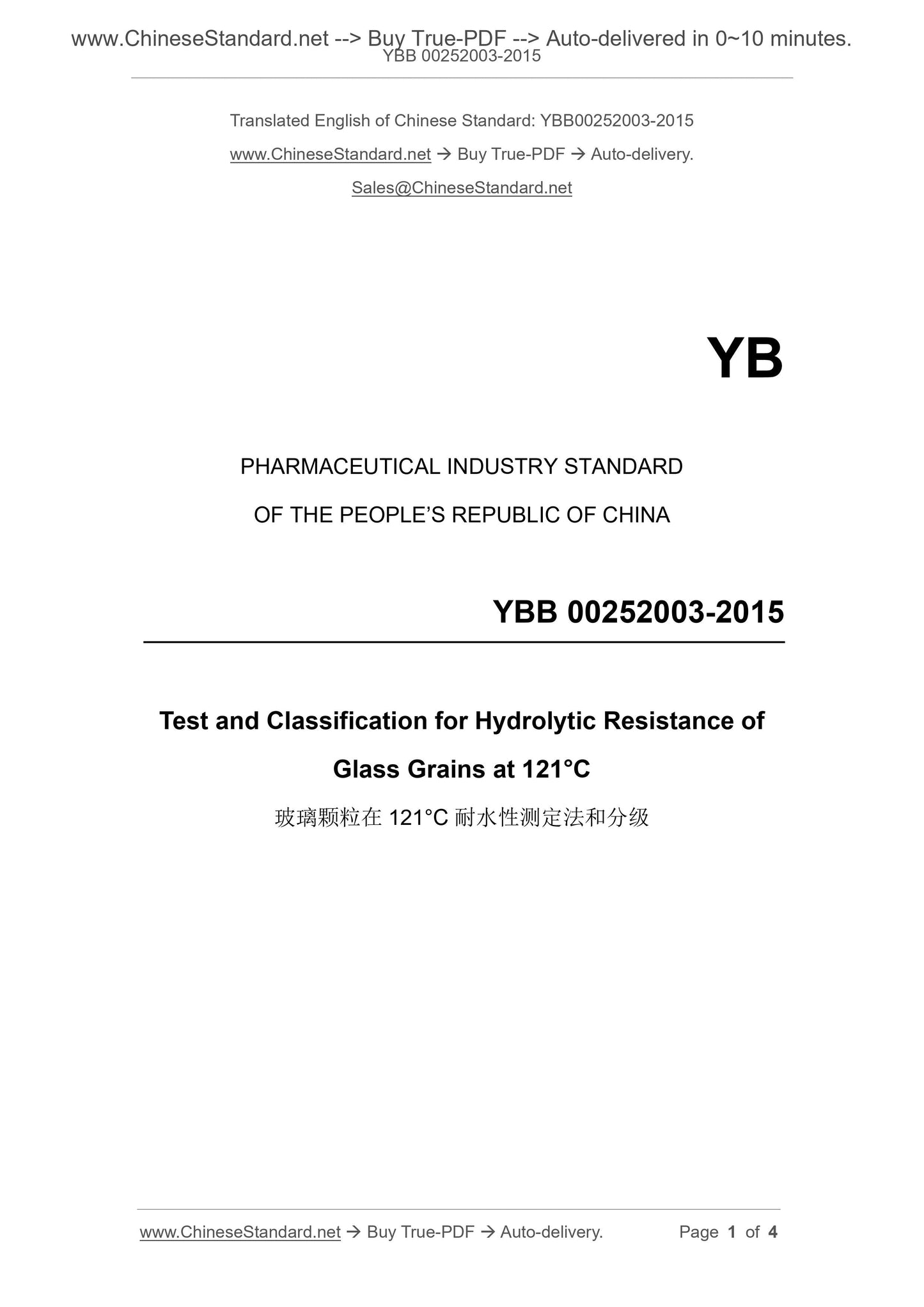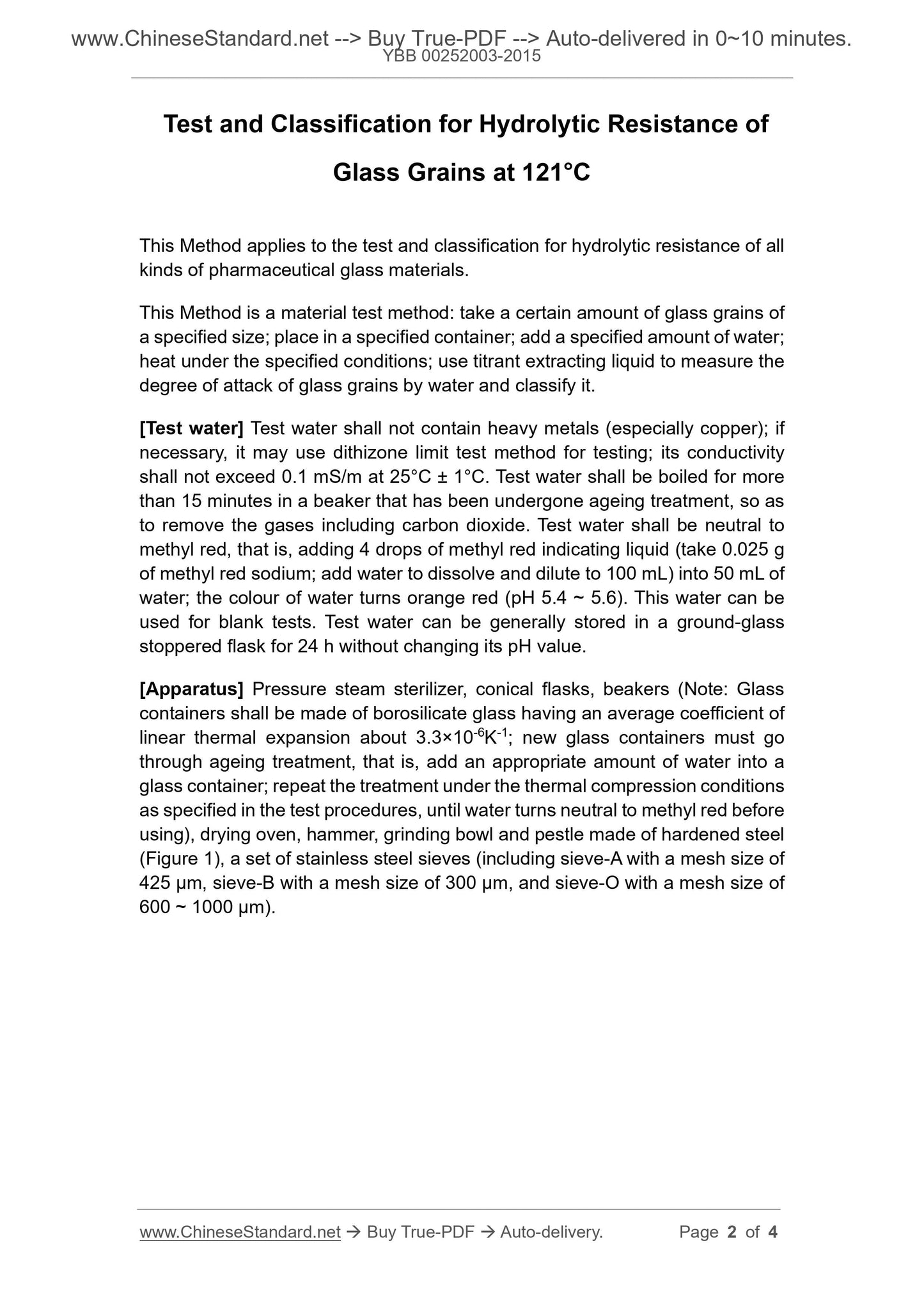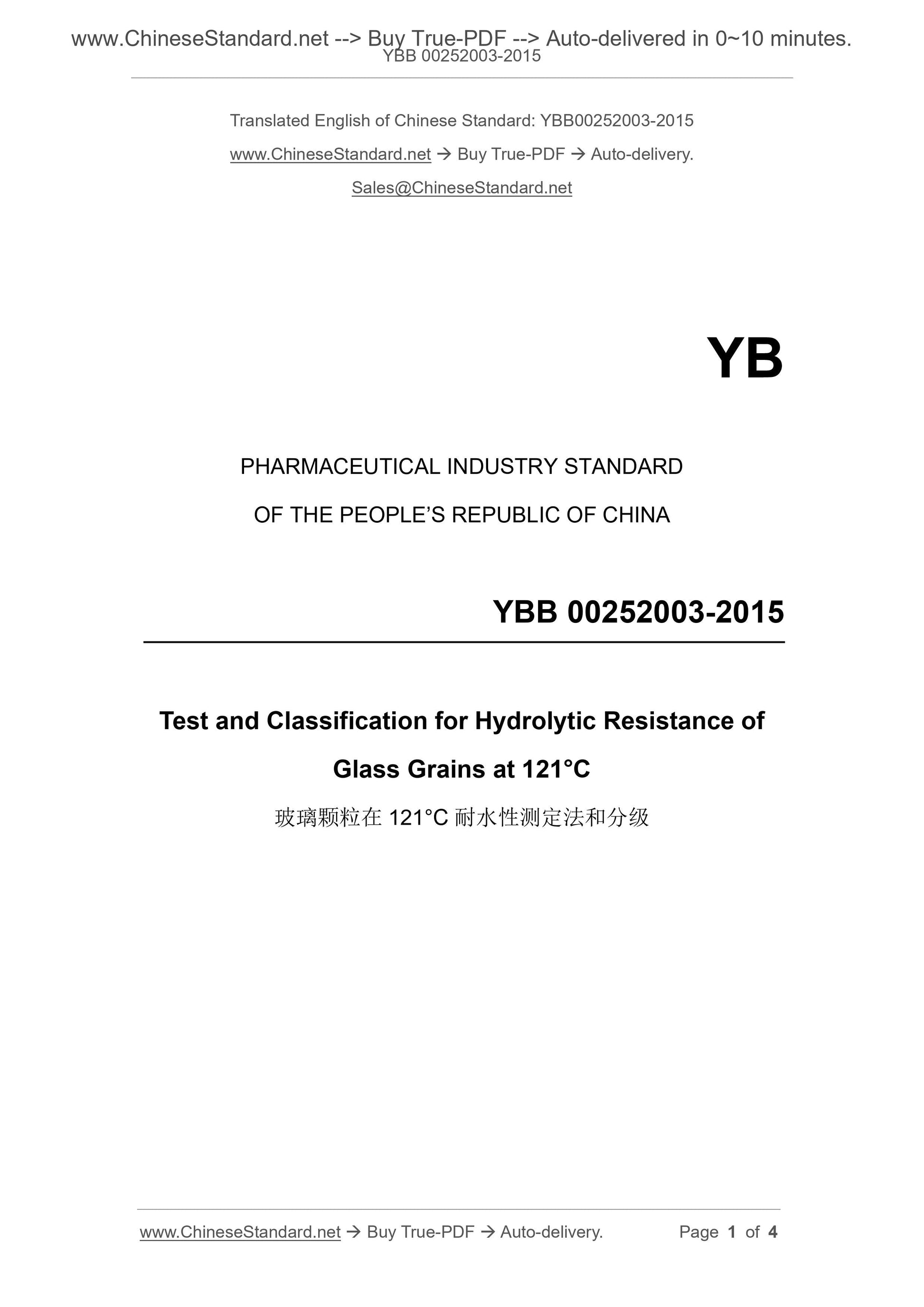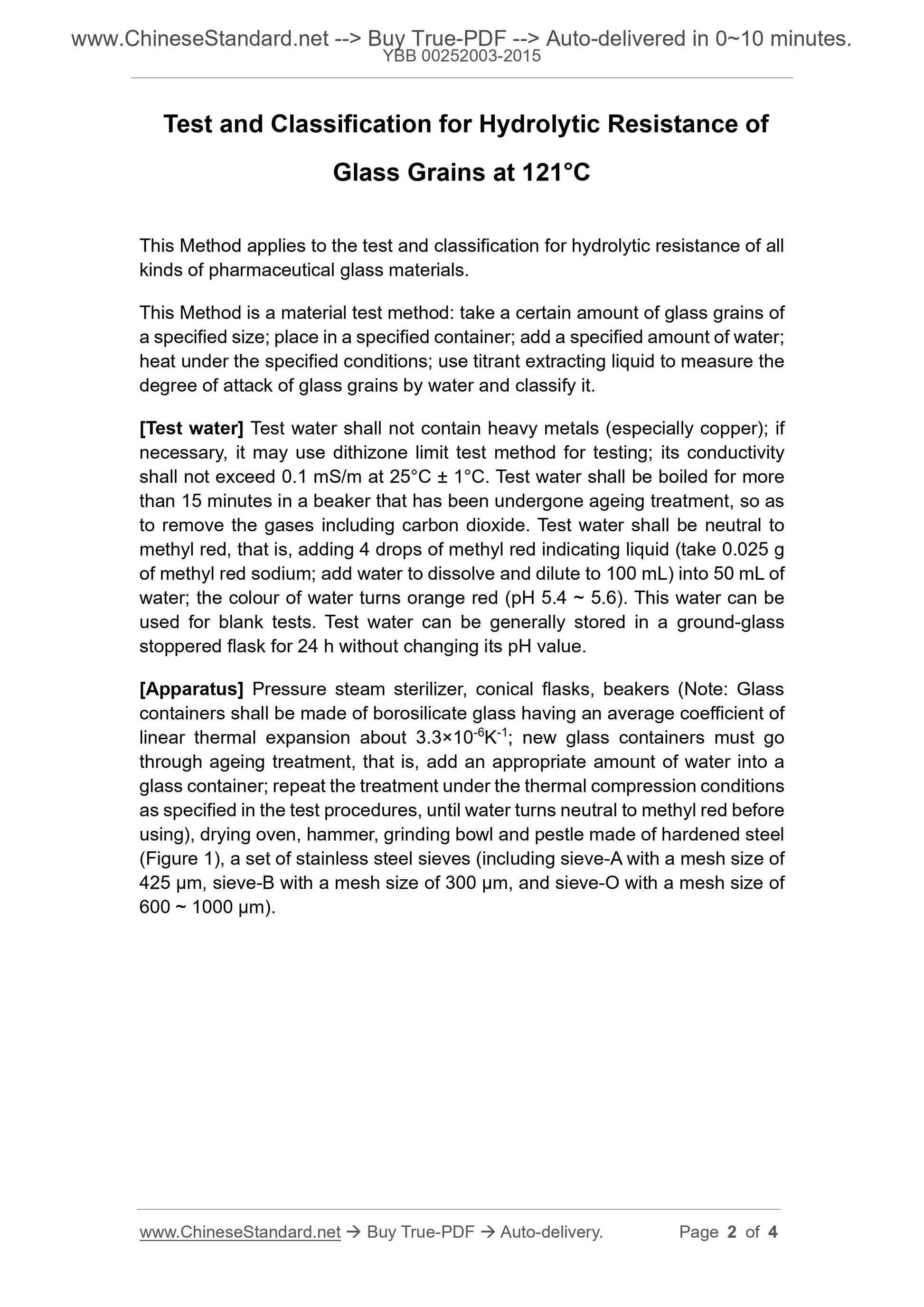1
/
of
2
PayPal, credit cards. Download editable-PDF and invoice in 1 second!
YBB 00252003-2015 English PDF (YBB00252003-2015)
YBB 00252003-2015 English PDF (YBB00252003-2015)
Regular price
$110.00 USD
Regular price
Sale price
$110.00 USD
Unit price
/
per
Shipping calculated at checkout.
Couldn't load pickup availability
Delivery: 3 seconds. Download true-PDF + Invoice.
Get QUOTATION in 1-minute: Click YBB 00252003-2015
Historical versions: YBB 00252003-2015
Preview True-PDF (Reload/Scroll if blank)
YBB 00252003-2015: Test and Classification for Hydrolytic Resistance of Glass Grains at 121-Celsius
YBB 00252003-2015
PHARMACEUTICAL INDUSTRY STANDARD
OF THE PEOPLE’S REPUBLIC OF CHINA
Test and Classification for Hydrolytic Resistance of
Glass Grains at 121°C
Test and Classification for Hydrolytic Resistance of
Glass Grains at 121°C
This Method applies to the test and classification for hydrolytic resistance of all
kinds of pharmaceutical glass materials.
This Method is a material test method: take a certain amount of glass grains of
a specified size; place in a specified container; add a specified amount of water;
heat under the specified conditions; use titrant extracting liquid to measure the
degree of attack of glass grains by water and classify it.
[Test water] Test water shall not contain heavy metals (especially copper); if
necessary, it may use dithizone limit test method for testing; its conductivity
shall not exceed 0.1 mS/m at 25°C ± 1°C. Test water shall be boiled for more
than 15 minutes in a beaker that has been undergone ageing treatment, so as
to remove the gases including carbon dioxide. Test water shall be neutral to
methyl red, that is, adding 4 drops of methyl red indicating liquid (take 0.025 g
of methyl red sodium; add water to dissolve and dilute to 100 mL) into 50 mL of
water; the colour of water turns orange red (pH 5.4 ~ 5.6). This water can be
used for blank tests. Test water can be generally stored in a ground-glass
stoppered flask for 24 h without changing its pH value.
[Apparatus] Pressure steam sterilizer, conical flasks, beakers (Note: Glass
containers shall be made of borosilicate glass having an average coefficient of
linear thermal expansion about 3.3×10-6K-1; new glass containers must go
through ageing treatment, that is, add an appropriate amount of water into a
glass container; repeat the treatment under the thermal compression conditions
as specified in the test procedures, until water turns neutral to methyl red before
using), drying oven, hammer, grinding bowl and pestle made of hardened steel
(Figure 1), a set of stainless steel sieves (including sieve-A with a mesh size of
425 μm, sieve-B with a mesh size of 300 μm, and sieve-O with a mesh size of
600 ~ 1000 μm).
Get QUOTATION in 1-minute: Click YBB 00252003-2015
Historical versions: YBB 00252003-2015
Preview True-PDF (Reload/Scroll if blank)
YBB 00252003-2015: Test and Classification for Hydrolytic Resistance of Glass Grains at 121-Celsius
YBB 00252003-2015
PHARMACEUTICAL INDUSTRY STANDARD
OF THE PEOPLE’S REPUBLIC OF CHINA
Test and Classification for Hydrolytic Resistance of
Glass Grains at 121°C
Test and Classification for Hydrolytic Resistance of
Glass Grains at 121°C
This Method applies to the test and classification for hydrolytic resistance of all
kinds of pharmaceutical glass materials.
This Method is a material test method: take a certain amount of glass grains of
a specified size; place in a specified container; add a specified amount of water;
heat under the specified conditions; use titrant extracting liquid to measure the
degree of attack of glass grains by water and classify it.
[Test water] Test water shall not contain heavy metals (especially copper); if
necessary, it may use dithizone limit test method for testing; its conductivity
shall not exceed 0.1 mS/m at 25°C ± 1°C. Test water shall be boiled for more
than 15 minutes in a beaker that has been undergone ageing treatment, so as
to remove the gases including carbon dioxide. Test water shall be neutral to
methyl red, that is, adding 4 drops of methyl red indicating liquid (take 0.025 g
of methyl red sodium; add water to dissolve and dilute to 100 mL) into 50 mL of
water; the colour of water turns orange red (pH 5.4 ~ 5.6). This water can be
used for blank tests. Test water can be generally stored in a ground-glass
stoppered flask for 24 h without changing its pH value.
[Apparatus] Pressure steam sterilizer, conical flasks, beakers (Note: Glass
containers shall be made of borosilicate glass having an average coefficient of
linear thermal expansion about 3.3×10-6K-1; new glass containers must go
through ageing treatment, that is, add an appropriate amount of water into a
glass container; repeat the treatment under the thermal compression conditions
as specified in the test procedures, until water turns neutral to methyl red before
using), drying oven, hammer, grinding bowl and pestle made of hardened steel
(Figure 1), a set of stainless steel sieves (including sieve-A with a mesh size of
425 μm, sieve-B with a mesh size of 300 μm, and sieve-O with a mesh size of
600 ~ 1000 μm).
Share




